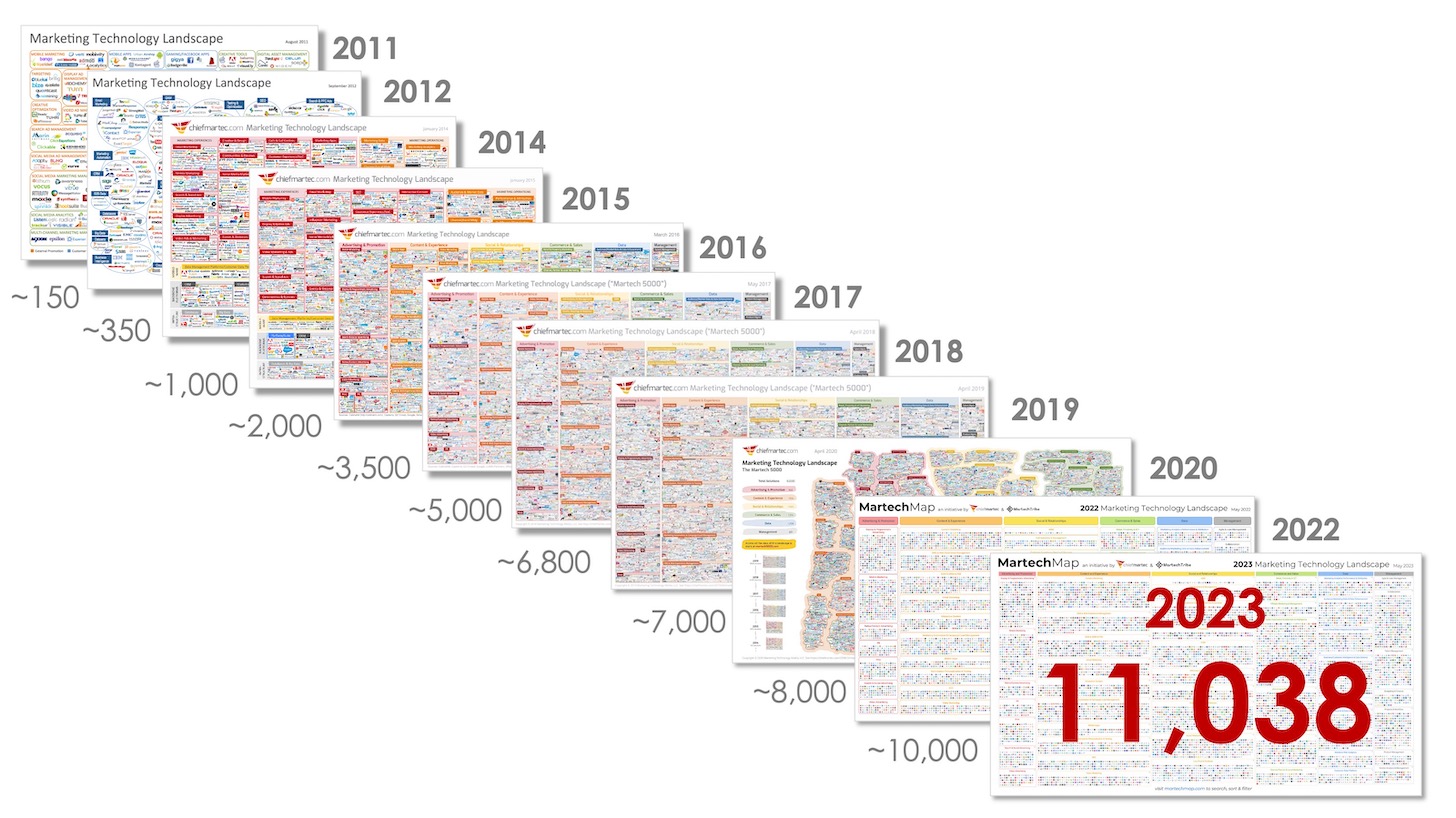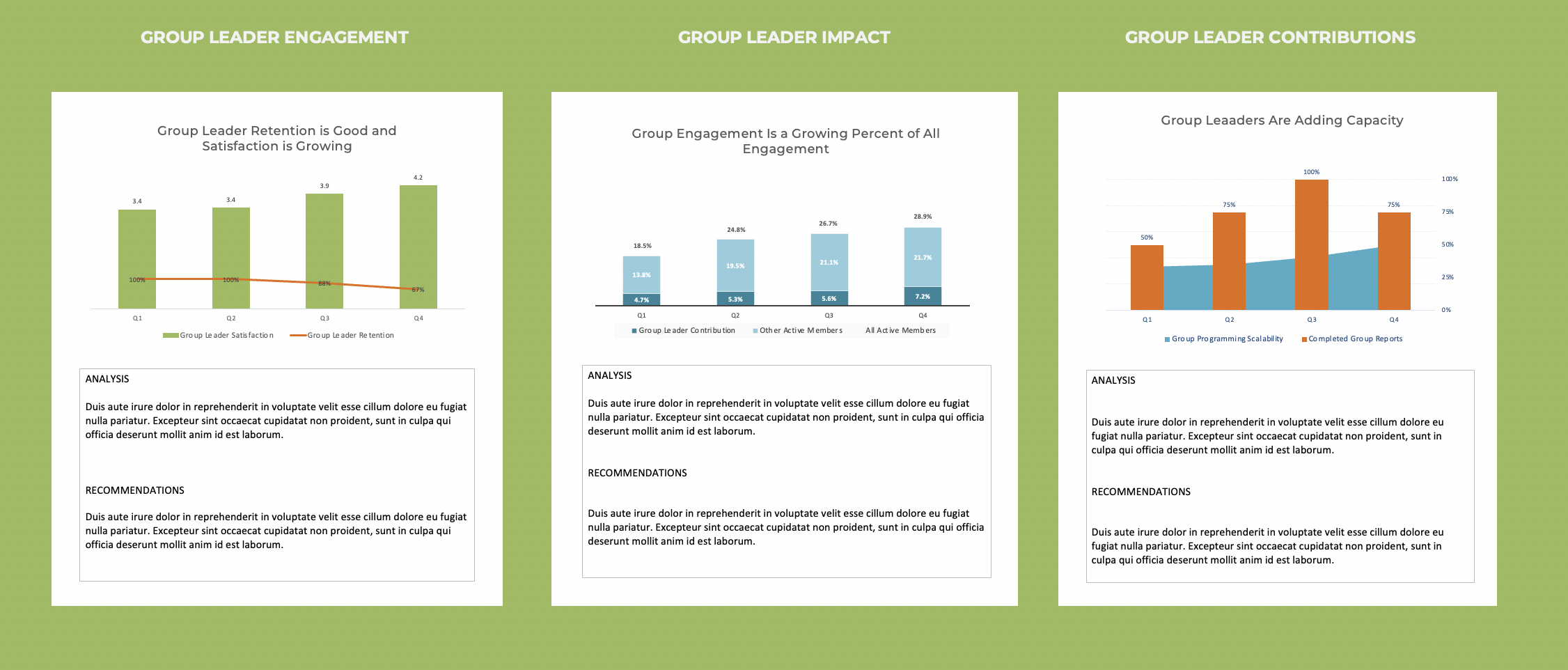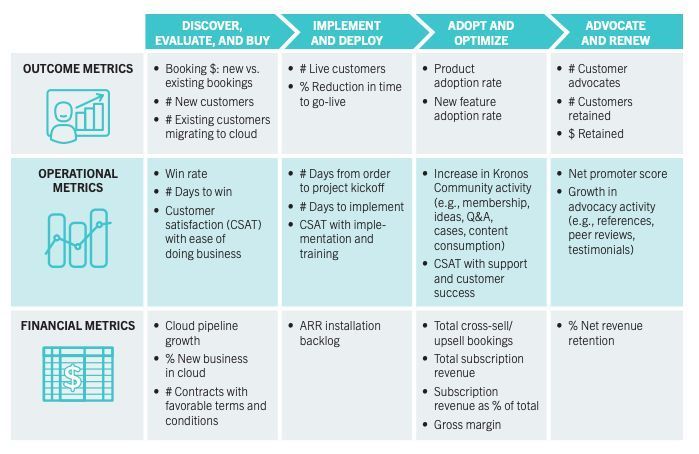Most executives do not think about the strategic cost of data, yet it is creating significant operational costs and adding immense friction for employees across organizations. With the move toward SaaS solutions that allow employees and departments to adopt software without centralized IT oversight, the quantity of organizational data has exploded.
In the Marketing space, Scott Brinker has reported on the Martec ecosystem for years, which ballooned from 150 applications in 2011 to over 11,000 in 2022. Each application comes with hundreds or thousands of data points.
Organizations are awash in data, with new data being metaphorically spit out every time someone sneezes.
It’s a lot of data.
Downing in Data and Starved for Meaning
Data and metrics feel comforting in a quickly moving world. We know that as individuals we can’t keep up.
The problem is that no amount of data can tell you what decision you should make. You can spend your entire life collecting, organizing, and calculating data and will be no better off than you are without it—but you will be more anxious and overwhelmed.
In the 1990s, I was a business analyst at a large consulting firm. I was on a project team assigned to assess and recommend ways to streamline IBM’s global supply chain architecture. In four months, it took me all over the world, scrambling after a partner and the project manager. The project manager and I did most of the interviews and data collection, and even then, we were drowning in data. The project manager’s approach was to collect and read as much as we could. Even then, I realized that we would never get to any kind of reasonable assessment in four months. There was simply too much data. Instead, we needed to start with a strategic hypothesis and only then decide information was relevant.
If organizations had too much data in the 1990s, then today’s organizational data is a tsunami that threatens to overwhelm it.
Keep Your Eyes on the Prize
My approach to ensuring an ROI for my data efforts is to first step away from the data. Like opening up a game or social media, you can lose hours of time mucking around in data and trying to make sense of it from the bottom up and it will come to nothing. It will more likely increase your confusion and overwhelm you rather than help you focus on what matters.
Next, figure out what matters, which can be much harder to define than it might seem. This requires time to reflect, conversations with others, and advice or examples from others who have done it before.
The questions to answer before wading through data:
- Who is the data meant to inform?
- How savvy are they about metrics?
- What other stakeholders do I want to inform?
- What matters to all of these stakeholders?
- What matters to the organization strategically?
- What metrics will help others understand what is meaningful?
- What metrics illuminate strategic progress?
- Which 3 business objectives does your work support?
- What metrics give a composite view of impact on business objectives?
- Which data is available to support these metrics?
Once you have a better sense of how the tactical things you do connect to strategic business objectives, it’s time to identify – from objective to metrics, to data – what will demonstrate it. Ensure it includes the following:
- Trends over time to see changes.
- Normalized metrics (percent of total) for accurate comparisons.
- Your analysis of what it means.
- Your recommendations based on progress.
When you have an initial design, go back to stakeholders to get their feedback before finalizing.
Finally, do yourself a favor and build a dashboard that is as automated as possible to reduce your time mucking about with data.
Limiting Analysis Paralysis
You’ve defined your dashboard. Now what?
You will probably get all sorts of requests for data, either because stakeholders look at the dashboard and want to dig deeper or because someone has a hypothesis about how data in your system connects to another system or an insight they can get. This curiosity is often great because it demonstrates that people are interested in what you are doing. However, it can also be a stalling tactic, a reactive way to avoid taking any risk, or a misplaced hope that somehow data will be able to tell them what they should do.
These requests can take up a lot of time and yield little, distracting you from the things that matter in making progress on the strategic metrics you have already defined or understanding what matters in impacting those metrics, both of which are far better uses of your time.
Insist on Simplicity
Because there is so much data, you will be tempted by your own curiosity and by the requests to go back to the vast well of data because maybe there is a pony in there somewhere…
Resist the temptation.
Having fewer metrics that tell a complete story and reporting it regularly results in a clear, broad understanding of your work. People are overwhelmed with data and information. Clarity and simplicity are scarce, refreshing, and memorable.
Jeff Breunsbach recently shared this excellent metrics dashboard, used by a mid-size organization with thousands of employees.
There are a few different reasons I love it:
- It is strategic
- It is clear and easy to understand.
- It educates others on what is meaningful
- It's narrative is centered on customers
- It aligns how (cycle time) with what (outcome)
The Value of Simple Metrics
Simplicity is hard.
However, simplicity gives the organization more time to create value.
Simplicity helps everyone understand the organization, its customers, and its value proposition.
Simplicity aligns the organizations by clearly connecting daily work to strategic priorities.
The Cost of Complicated Metrics
Simplicity in organizational metrics is not the norm, especially now when everything can be tracked and measured.
The operational cost to an organization is enormous, and it is driven by anxiety, a need for control, and the lack of trust in ourselves and others.
Employees spend so much time on metrics so they can justify their value in organizations that do not always seem to value them, for managers who are not always invested in supporting and promoting them. Because of constant layoffs, employees feel the need to constantly justify their worth.
Too often, people assume simplicity in metrics is about understanding how to simplify data, but it is really about insecurity, a toxic culture driven by misalignment of motivators, and leaders who do not understand the dynamics and needs of the human system operating alongside the mechanical system.
If you want simplicity in operations – including metrics – you have to invest in a culture of connection and trust first.






